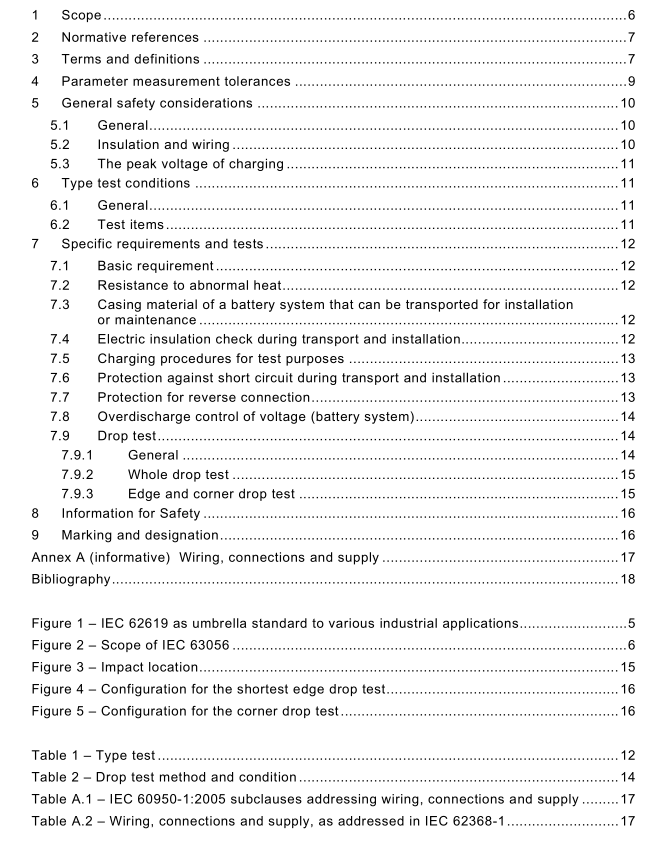IEC 63056 pdf – Secondary cells and batteries containing alkaline or other non-acid electrolytes – Safety requirements for secondary lithium cells and batteries for use in electrical energy storage systems

IEC 63056 pdf – Secondary cells and batteries containing alkaline or other non-acid electrolytes – Safety requirements for secondary lithium cells and batteries for use in electrical energy storage systems
These tolerances comprise the combined accuracy of the measuring instruments, the measurement techniques used, and all other sources of error in the test procedure. The details of the instrumentation used shall be provided in any report of results.
5 General safety considerations
5.1 General Battery systems and the cells they contain shall comply with the applicable general safety considerations of IEC 6261 9. Within the standard temperature range, secondary cells can be charged at the maximum charge current, which is specified from a safety point of view. Lithium-ion cells shall always be operated within the operating region values and the storage conditions specified by the manufacturer. The safety of lithium secondary cells and battery systems requires the consideration of two sets of applied conditions:
1 ) intended use;
2) reasonably foreseeable misuse. Cells and battery systems shall be so designed and constructed that they are safe under conditions of both intended use and reasonably foreseeable misuse.
It may also be expected that cells and battery systems subjected to intended use shall not only be safe but shall continue to be functional in all respects. It is expected that cells or battery systems subjected to misuse may fail to function. However, even if such a situation occurs, they shall not present any significant hazards. Potential hazards which are the subject of this document are:
a) fire,
b) burst/explosion,
c) critical electrical short circuit due to leakage of cell electrolyte, mechanical deformation or incorrect installation, d) venting that continuously vents out flammable gases, e) rupture of the casing of cell, module, battery pack, and battery system with exposure of internal components. Conformity is checked by the tests in accordance with the appropriate standards in Clause 2. Moving parts that have potential to cause human injuries shall be applied appropriate design and necessary measures in order to reduce the risk of injuries, including those that may be incurred during installation while cells or battery systems are being incorporated into equipment.
5.2 Insulation and wiring Wiring and its insulation shall be sufficient to withstand the maximum anticipated voltage, current, temperature, altitude and humidity requirements. The design of wiring shall be such that adequate clearances and creepage distances are maintained between conductors in accordance with IEC 60950-1 :2005, 3.1 and 3.2 (test temperature relies on the battery system’s operating region specified by the manufacturer). Hazardous live parts of the battery system shall be protected to avoid the risk of electric shocks, including during installation.
The mechanical integrity of the whole battery system (cell/module/BMS) and their connections shall follow the requirements from the end-use equipment manufacturer. When there are no requirements provided from the end use equipment in which the battery system is to be installed, Annex A may be used. The battery system manufacturer shall indicate the maximum allowed number of series connections of a module or a battery system in the specification or instruction manual.
5.3 The peak voltage of charging When a charging current has an alternating component, a battery system manufacturer shall ensure that the peak voltage of the charging current is under the upper limit charging voltage, specified by the battery system manufacturer, by monitoring the voltage of every single cell or cell block.
6 Type test conditions
6.1 General A battery system that is used outside of its operating region may exhibit hazards resulting from the cells or battery system. Such risks have to be taken into consideration in order to prepare a safe test plan. The test facility should have a sufficient structural integrity and a fire suppression system to sustain the conditions of overpressure and fire that may occur as a result of testing. The facility should have a ventilation system to remove and capture gas that might be produced during the tests. Consideration should be given to high-voltage hazards when applicable.









